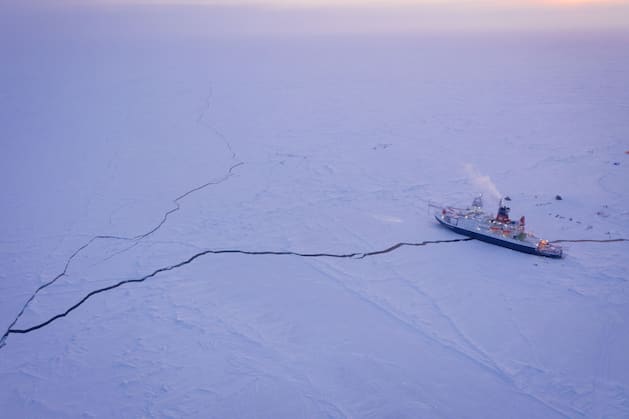Climate change is causing thin ice in the Arctic. Actually, this should alarm the world’s great powers. Instead, they hope for one thing above all from the melting ice: economic profit. The competition is dangerous.
The ice in the Arctic is melting at a rapid pace. In hardly any other place are the effects of climate change as dramatic as there. Still, Russia, China and the US are eyeing the shrinking ice sheet greedily. As it thins out, the once neglected polar region is becoming an increasingly coveted and thus contested geostrategic hotspot – and a point of contention between the great powers.
Impressive ice landscapes as far as the eye can see, the area is rough but beautiful. The reason why Russia’s Vladimir Putin, China’s Xi Jinping or US President Joe Biden are reaching out to the Arctic, however, is different. According to the UN Convention on the Law of the Sea of 1982, the so-called “Northeast Passage” has so far been international waters.
According to this, the five neighboring states, i.e. Russia, the USA, Canada, Denmark and Norway, may each claim a 350 nautical mile wide economic zone along their mainland – the remaining area is not assigned to any state. Whoever controls the entire zone in the future could achieve a significant economic competitive advantage. With the disappearance of the ice cover, new trade routes between Asia and Europe are opening up. On the normal route, a ship from Shanghai to Hamburg currently needs 25 days, via the Northeast Passage it would take 15 days in the future.
Those who control this trade have an effective leverage in conflicts. The rising and strongly export-driven economic power China could bring a blockade of world trade to its knees. China has therefore shown interest in the Arctic since the 1980s – although the country is obviously not permitted to make any territorial claims. In 2018, the People’s Republic called itself the “Near riparian” of the Arctic for the first time. The reason: China is one of the countries on the Asian continent that is closest to the Arctic Circle. Xi Jinping aspires to control the “Polar Silk Road” in addition to the New Silk Road in Central Asia. Only a few ships can still pass through the Northeast Passage because of the ice.
Another factor that lures the three great powers lies deep beneath the ice sheet. Scientists estimate that the Arctic contains about 30 percent of undiscovered natural gas and 15 percent of undiscovered oil. The Ukraine war in particular made it clear how much influence a nation’s energy resources have on its position in world politics. Russia has by far the longest Arctic border of all neighboring countries. The Russian government estimates that the submerged continental shelf claimed by Russia contains up to five billion tons of oil and gas valued at US$30 trillion.
But that’s not all: Rare earths, which are essential for modern technologies and the energy transition, are also found in the Arctic. Only climate change makes the exploitation of these raw materials possible. All states are equally dependent on these resources, although China already controls the global market. Beijing definitely doesn’t want to lose this monopoly.
In addition to the economic aspects, the three parties, but especially Russia and the USA, are competing for the Arctic as a military base. For Putin, the polar region would be a strategically well-placed starting point from which to attack the West. Russian medium-range missiles, for example, could reach the US state of Alaska from there. The USA and NATO see this as a threat to their territorial security, which is why all sides in the polar region have been arming themselves for several years. Putin shows his intention most aggressively. He let the media see nuclear submarines through a layer of ice and set up Russian flags on the seabed. China, on the other hand, is trying to buy into the northern countries of the polar region with investments instead of warships.
So far, the US and its allies have reacted calmly to the military muscle flexing, but fears of an attack on the polar region are growing in Norway, Finland and Sweden, especially after the Russian invasion of Ukraine. The NATO countries are therefore planning to increasingly train their soldiers in the polar region – especially those nations whose soldiers are not used to fighting in cold regions. If the military of Russia and NATO soon face each other here, it is extremely dangerous. However, a dialogue seems unrealistic in times of the Ukraine war.








